Quick and Flavorful Gluten-Free Dinner Recipes
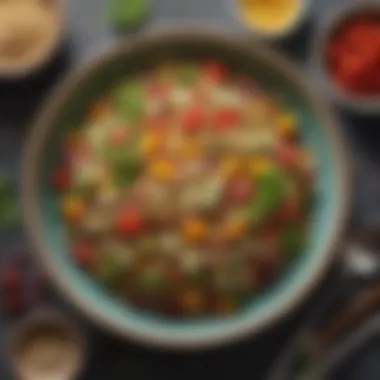

Intro
In today's fast-paced world, juggling work, family, and personal commitments can be overwhelming. For those who follow a gluten-free diet, finding time to prepare delicious and nourishing meals often adds to the challenge. This article provides a useful guide to essential gluten-free dinner recipes tailored for busy lifestyles, emphasizing simplicity without sacrificing flavor and nutrition.
Navigating choices in the kitchen need not be a daunting task. With practical recipes, the right techniques, and forward-thinking meal planning, individuals can whip up vibrant meals in minimal time. The contained information presents both flavor and wellness, aiding those seeking adventure in their cooking while still adhering to gluten-free principles.
We'll explore recipes that are not just quick but promise to please the palate, going through step-by-step instructions, nutritional insights, and expert time-saving cooking tips. Let us begin this culinary journey beneficial not only for the body but also for one's mental space in a busy schedule.
Recipe Highlight
One-Pan Lemon Herb Chicken and Broccoli
This recipe maximizes flavor and minimizes cleanup, ideal for busy evenings.
Essential Ingredients Needed:
- Chicken breasts (4 pieces)
- Fresh broccoli florets (3 cups)
- Olive oil (3 tablespoons)
- Lemon juice (from 1 large lemon)
- Garlic powder (1 ½ teaspoons)
- Salt and pepper to taste
Time to Prepare: Approximately 30 minutes
Serving Yield: Serves 4
Step-by-Step Instructions
- Start by preheating your oven to 400°F (200°C).
- In a large bowl, combine the chicken breasts, olive oil, lemon juice, garlic powder, salt, and pepper. Make sure the chicken is evenly coated.
- On a large baking tray, arrange the marinated chicken breasts down the center. Toss the broccoli florets in the remaining olive oil, coating them well, and place them around the chicken.
- Bake in the preheated oven for 20-25 minutes or until the chicken reaches an internal temperature of 165°F (75°C).
- Once cooked, let the meal rest for a few minutes before serving. This allows juices to redistribute, keeping the chicken moist.
Cooking Tip: To retain the intense flavor of the dish, try searing the chicken in a skillet for a couple of minutes before placing it in the oven.
Variations and Substitutions
To adjust the recipe for personal taste or dietary needs, consider these alternatives:
- Chicken Alternatives: Substitute with firm tofu or chickpeas for a vegetarian option.
- Veggie Add-ins: Along with broccoli, feel free to toss in bell peppers, zucchini, or carrots.
- Herbs & Spice Flavor Boost: Experiment with fresh rosemary, thyme, or a dash of cayenne pepper.
Pair it beautifully with quinoa or a fresh garden salad to boost nutrition and crunch.
Time-Saving Cooking Tips
- Prep Ahead: Overnight marination of chicken can uplift flavors, making it quick to dive into cooking.
- Batch Cooking: Prepare large amounts of roasted vegetables once a week; these can enhance many dishes with minimal effort.
- Tools to Streamline: Use a good-quality chef's knife for speedy chopping and a non-stick baking sheet for easy cleanup.
Nutritional Information
- Calories (per serving): Approximately 340 calories.
- Key Nutrients:
- Diet Suitability: This recipe adheres not only to gluten-free guidelines but also qualifies as lower-carb and can be adjusted to lean towards a straightforward paleo diet with easy tweaks. Considering the primary ingredients, it is an excellent option for families seeking both nutrition and convenience in their weeknight feasting.
- Protein: 34g
- Fiber: 3g
- Saturated fats: 5.5g
Prolusion to Gluten-Free Cooking
The rise in gluten sensitivity and awareness about celiac disease has made gluten-free cooking essential for many households today. This section introduces the topic and sets the stage for understanding the practicalities involved in gluten-free meal preparation.
Understanding Gluten and Its Impact
Gluten is a protein found in wheat, barley, and rye. Many people can consume gluten without issues, yet for those intolerant to it, this simple protein can cause significant health problems. Those with celiac disease or non-celiac gluten sensitivity may experience a range of uncomfortable symptoms when consuming even small amounts. This has prompted an increasing number of individuals to adopt gluten-free diets to avoid these negative effects. To put it simply, if gluten allergies or intolerances affect one’s day-to-day, understanding gluten's presence in foods is crucial. Recogizing common gluten-containing items helps in making better food choices.
Benefits of Gluten-Free Meals
Choosing gluten-free options presents several advantages that extend beyond allergy concerns. For many, gluten-free meals offer substantial benefits:
- Improved Health: Many gluten-free foods are naturally richer in certain nutrients due to the incorporation of alternative grains like quinoa or brown rice.
- Enhanced Energy Levels: Without the heavy occurrence of gluten, many individuals report better energy throughout the day.
- Greater Variety: Exploring gluten-free recipes can lead cooks to discover new ingredients and flavors that might be overlooked in a conventional diet.

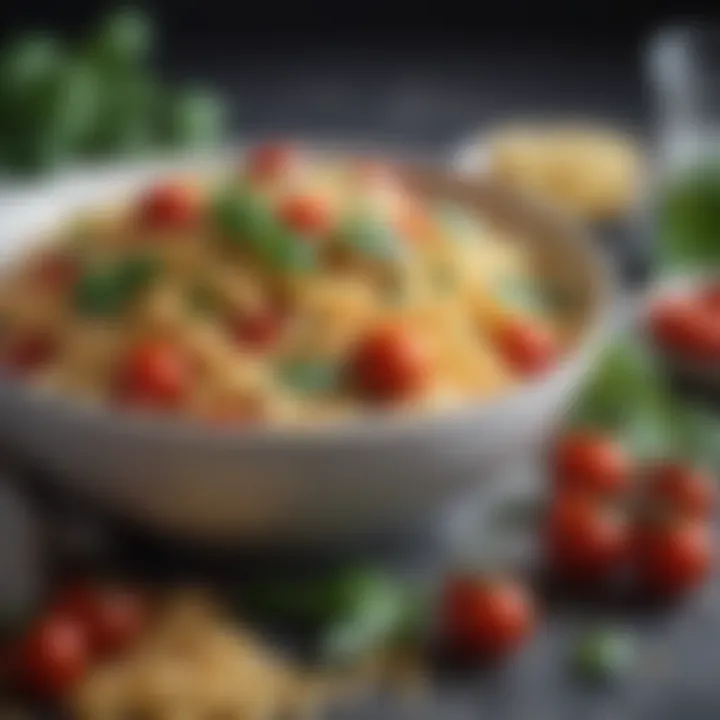
Highlighting these benefits contributes to a broader understanding of how gluten-free cooking goes beyond mere dietary restrictions. Overall, choosing a gluten-free dining approach can result in more informed eating habits and ultimately, a more balanced diet.
Preparation Tips for Gluten-Free Cooking
Preparation and meticulous planning can transform gluten-free cooking from challenge to convenience. This section provides essential guidance that maximizes the enjoyment of your gluten-free meals. Beyond simplifying the cooking process, understanding how to efficiently source, store, and use gluten-free ingredients can lead to health benefits and improved overall nutrition. By mastering these tips, busy individuals can ensure their meals are both satisfying and nourishing.
Essential Ingredients for Gluten-Free Recipes
Choosing the right ingredients is fundamental when adapting recipes for gluten-free living. Essential elements include gluten-free grains, like quinoa and rice, that can form the backbone of most dishes. Additionally, alternative flours—such as almond, coconut, and chickpea flour—offer varied flavors while maintaining necessary texture.
- Gluten-Free Grains: These grains are high in fiber, contributing necessary nutrients. Quinoa, buckwheat, and millet provide variety and nutrition.
- Flours: Switch to flours that lack gluten. Items like almond flour not only serve as versatile substitutes, but they also enhance protein intake.
- Thickening Agents: Instead of traditional flour, options like cornstarch or arrowroot powder can thicken sauces and soups without gluten.
- Legumes: Bean and lentil varieties not only substitute wheat-based proteins but add substantial health benefits as well.
It is crucial to check labels for gluten. Cross-contamination can happen easily, affecting those who are highly sensitive to gluten. One's pantry can reflect this careful selection of ingredients and knowledge surrounding gluten-free cooking. Working with gluten-free ingredients encourages both creativity and health-conscious choices.
How to Avoid Cross-Contamination
For those who must eliminate gluten from their diets, vigilance against cross-contamination is vital. Even trace amounts of gluten can lead to significant health consequences, making this aspect of meal preparation paramount. Adopt the following measures to create a safe cooking environment:
- Designate Counter and Prep Areas: Having a specific space for gluten-free food preparation minimizes the risk of contamination with gluten-containing items.
- Use Separate Utensils: Always designate separate cutting boards, spoons, and pots for gluten-free cooking. This simple step is critical in preventing cross-contact.
- Thoroughly Clean All Surfaces: Before starting, ensure that all surfaces and equipment are cleaned accordingly. Removing crumbs from gluten dishes is essential.
- Rinse Naturally Sticky Foods: Foods such as beans may come in cans that could have come into contact with gluten. Rinse to ensure safety.
Quick Gluten-Free Dinner Ideas
In a fast-paced world, having quick gluten-free dinner ideas is essential for both family and individual meals. This allows individuals to savor delicious meals while accommodating dietary restrictions. Efficiency should not count out flavor or nutrition, creating an interesting dynamic in meal preparation.
Meal preparation can often feel overwhelming, especially when time is not on your side. However, integrating simple and quick gluten-free recipes into your routine can make the dinner process noticeably more streamlined. With a focus on ease and time-saving methods, these quick dinner solutions promise satisfaction
One-Pan Meals for Efficiency
One-pan meals stand out for their simplicity and minimal cleanup, which is a blessing when evening schedules get tight. These meals reduce time spent in both preparation and cooking, allowing more focus on family or personal downtime.
Common ingredients for these meals include vegetables, proteins, and flavor enhancers. Consider keeping a variety of proteins, such as chicken breast, beef strips, or even shrimp, handy. Seasonal vegetables like zucchini, bell peppers, and spinach add vibrant flavors without requiring extensive preparation. A basic seasoning mix of garlic powder, salt, and pepper can transform bland into enjoyable without hassle.
Example dishes might include:
- Chicken and Vegetable Skillet: Simply sauté diced chicken in olive oil, add a mix of chopped vegetables, season accordingly, and cook until everything is tender.
- Shrimp with Asparagus: Stir-fry shrimp with fresh asparagus. An entourage of lemon juice and a knows dash of chili flakes assures tastiness.
These recipes can be changed with whatever seasonal or favorite veggies are available. Thus, they become a flexible meal-resource throughout any busy week.
Pasta Alternatives: Beyond Traditional Noodles
Replacing traditional wheat pasta can open a world of gluten-free options that essentially mimic the textures and flavors fans are used to. Pasta alternatives can range from rice noodles to spiralized zucchini, providing varied ways to present meals without a hint of gluten.
Using joseph's Lavash bread as an example can serve suits for many pasta-like applications. Cuts Lasavsh by way of tiny triangles then toast up as chips for nachos or toppings on salads. Other alternative options, include:
- Zucchini Noodles: These are not only quick to prepare using a spiralizer, but also add an enjoyable crunch.
- Quinoa Pasta: Designed specifically to mimic traditional noodle forms, shifting meetings to embrace more healthy carbs.
- Chickpea Pasta: Increased moisture-retention offers surprisingly pleasing results in both taste and nutrition.
Integrating GF pastas into one’s rotation gradually redefines the dining experience. Encouraging discovery leads to incorporating basic pantry items to springboard diversity.
Hearty Gluten-Free Options
Hearty gluten-free options form a crucial element of gluten-free cooking. These options not only satisfy hunger but also supply necessary nutrients and flavors. They aid in maintaining enthusiasm for gluten-free diets, allowing individuals and families to feel full and nourished without the frustration of blandness or repetition. Selecting the right hearty recipes ensures that busy schedules do not lead to skipped meals or unhealthy fast food choices.
All gluten-free dishes listed here are designed to be filling and attractive. Keeping in mind diverse dietary preferences is essential. For instance, many people struggle to source adequate protein in gluten-free meals. Protein-rich foods play a vital role in muscle repair, immune function, and overall health. Therefore, it's beneficial when planning meals that cater to these critical needs.
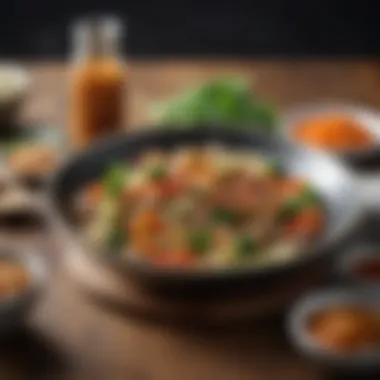
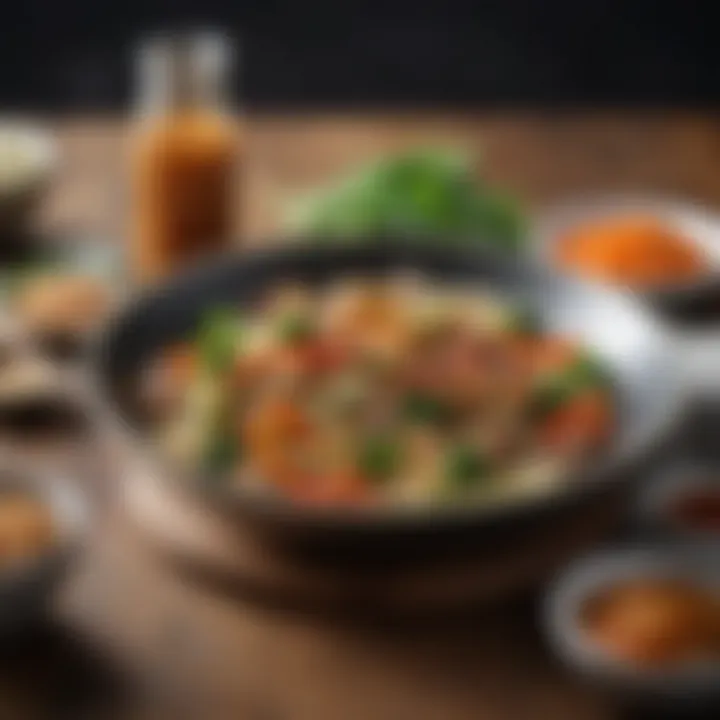
Protein-Packed Dinner Choices
Protein-packed dinner choices are a creative space wherein obesity meets satisfaction. Integrating these into immediate dinner plans can significantly enhance nutrition. Consider sources such as grilled chicken, beef, and fish. For vegetarians or vegans, incorporate quinoa, lentils, or chickpeas packed with protein. Here are some examples of meals that can be made quickly:
- Grilled Chicken with Roasted Vegetables: Season chicken with spices or gluten-free marinades and grill it until cooked through. Serve with seasonal veggies for color and nutrients.
- Stuffed Bell Peppers: Use turkey or beans along with rice for stuffing. Top with cheese if desired. Bake until peppers are fork-tender.
- Seared Fish: Fish like salmon is not just quick to cook but also rich in omega-3 fatty acids. Pair it with a fresh salad or quinoa for a nutritious feast.
It's critical that meals retain texture and flavor. Marinades and spices can transform simple ingredients into delightful dinners, encouraging the use of local herbs and spices to innovate dishes. Remembering that exciting textures in food leads to rave responses around the dining table.
Vegetarian and Vegan Gluten-Free Recipes
Vegetarian and vegan gluten-free recipes expand on the culinary framework and critically engage with nutrient density. Plant-based meals often rely on ingredients that naturally lack gluten, making it simpler to ensure the meals remain gluten-free. Creating satisfying vegetarian or vegan dishes involves utilizing a mix of textures and flavors.
Consider these nourishing gluten-free he entrées:
- Chickpea Curry: Cook chickpeas with coconut milk, spices, and applaing vegetables. Serve with rice or gluten-free flatbreads for completeness.
- Vegetable Stir-fry: Combine a medley of your favorite vegetables with tofu or tempeh cooked in gluten-free soy sauce or tamari.
- Sweet Potato and Black Bean Tacos: These are easy to prepare and delicious. Just mash boiled sweet potatoes then top them with seasoned black beans. Add a variety of toppings like avocado and salsa.
In merging proteins with plant-based options, meals still adhere to upper limits of satisfaction. Vegetarian and vegan recipes aid in keeping dishes not only wholesome but also appealing.
Cooking gluten-free may appear to stress culinary versatility; however, through hearty options, the seamless introductions of solid nutrition remains key. These sections. are manageably adaptable for changing tastes. With commitment to hearty gluten-free meals, rest assured everyone in your home can engage meaningfully around shared dinner experiences.
Meal Prep Strategies for Gluten-Free Dinners
Meal prep is a game changer for those following a gluten-free diet, especially for individuals and families with busy lifestyles. Developing effective meal prep strategies aids in seamless incorporation of gluten-free recipes into the weekly routine. This practice not only saves time but also ensures access to nutritious meals that align with dietary restrictions. Planning ahead enables clear understanding of ingredient requirements and keeps wasted food in check. It also helps cultivate a sense of control over one’s meals, which many find empowering.
Batch Cooking Essential Dishes
Batch cooking essential dishes provides the foundation for effortless gluten-free dinners throughout the week. By dedicating just a few hours one day a week, one can prepare multiple servings of staple items like quinoa, brown rice, or lentils which serve as the base for various meals. These versatile components can be made in larger quantities and stored for quick assembly later.
Some popular batch-cooked dishes to consider are:
- Chili: This dish hits the spot. Hearty and filling, it incorporates lentils, beans, or ground meat combined with tomatoes and spices.
- Soups and Stews: Another superb option. Choose stock-based or pureed variants with veggies and gluten-free grains.
- Grilled Chicken or Salmon: Proteins are often the longer cook times. Prepare larger pots at once and repurpose them in wraps, salads, or with vegetable sides.
These dishes can adapt to flavor preferences. It is easy to switch spices or add different vegetables based on seasonal availability. When it comes to portioning rot; tis good to separate these into containers right away. In this filtering process, consideration should be given to meal types consuming f.eks breakfast, lunch, dinner for efficient retrieval.
Storing Gluten-Free Meals for Later Use
Storing gluten-free meals effectively is crucial in maintaining food quality and ensuring convenience. After cooking, understanding storage options can minimize waste while maximizing the tasty flavors that gluten-free dishes bring.
Food can be stored in containers that allow easy access while also protecting against potential freezer burn. Consider glass meal prep containers with lids that seal well to maintain freshness. When storing gluten-free meals, do these:
- Label each container with the dish name and date prepared to avoid confusion and manage shelf life.
- Cool the dishes to room temperature before refrigeration or freezing to maintain flavor and prevent moisture build-up.
- Freezing pasta alternatives or individual proteins can help save time for future dinners, promoting variety in meal rotation.
Most importantly, minimize trips to the freezer for portions bigger than necessary when cooking. Not all meals take longer to thaw frozen items. This incremental thaws keep things organized.
Effective meal storage maximizes flavor retention and maintains nutritious standards.
By utilizing these meal prep strategies along with batch cooking, one can enjoy an assortment of gluten-free dinners without challenges typical of busy schedules. With thoughtful consideration on which dishes to prepare and the methodology behind their storage, individuals can easily stay aligned with dietary goals.
Family-Friendly Gluten-Free Recipes
Finding recipes that meet the dietary needs of every family member can be challenging, especially for those who follow gluten-free diets. This section addresses the importance of family-friendly gluten-free recipes in creating a harmonious dining experience. By emphasizing meals that even picky eaters will love, we take an inclusive approach to encourage healthy family eating habits. Gluten-free options can be exciting and tasty, rather than fall within the constraints often regarded as bland or unsatisfying.
Key Benefits of Family-Friendly Gluten-Free Recipes:

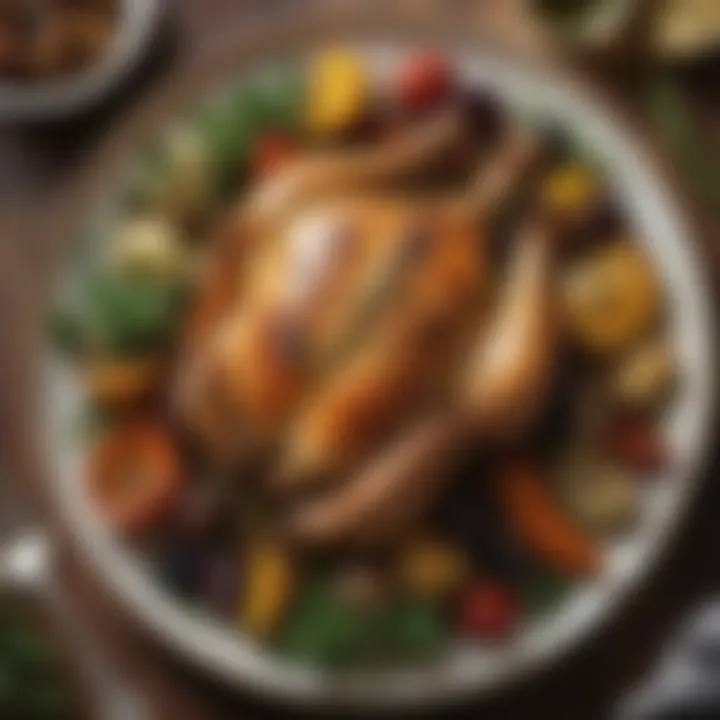
- Nutritional Balance: These meals can provide important nutrients for growing children.
- Inclusivity: Helps accommodate dietary restrictions while still keeping everyone engaged at the table.
- Culinary Connections: Cooked together as a family, encouraged conversations boost time spent bonding while learning about nutrition.
Kid-Approved Dinner Ideas
When it comes to dinner, a culinary masterpiece is great, but practicality usually wins. Kid-approved recipes often feature simple, recognizable ingredients that appeal to children's tastes. A satisfying meal without heavy influence of gluten can be achieved by incorporating several flexible favorites.
Some appealing ideas include:
- Gluten-Free Taco Night: Provide various toppings to allow personal customization. Taco shells made from corn are convenient and loved by children.
- Mini Gluten-Free Pizzas: Use gluten-free tortillas or cauliflower crust. Let kids create their own toppings for meals that's fun and energetic.
- Chicken Tenders: Use gluten-free breadcrumbs or almond flour for healthier finger food options.
Involving Children in Meal Prep
Encouraging children to participate in meal prep offers several benefits behind just having fun. When children help prepare their food, it boosts their willingness to eat it as they feel more involved. Here's effective techniques to include them:
- Assign Age-Appropriate Tasks: Small orders like washing and peeling veggies can be encouraged for toddlers. Older children can stand at the stove under supervision, guiding them in cooking their selection.
- Use Fun Tools: Cookie cutters and rolling pins can make preparing ingredients enjoyable. Children enjoy manipulating ingredients into fun shapes.
- Create a Cooking Game: Turn preparation into a challenge, like creating the ugliest pizza. This can take healthy choices forward while discuting the glittering difference makes between fun food and trading off engaging methods meant to sway unhealthy habits that go unnoticed.
Helping children understand different foods develops appreciation, knowledge and creates fun times around dinnertime
Family-friendly gluten-free recipes hold the potential not only to support physical health but also to reinforce family values and communication patterns when enjoyed together. By choosing appealing menu items and fostering a collaborative cooking environment, everyone benefits in the long run.
Satisfying Gluten-Free Comfort Foods
Comfort food holds a special place in our hearts and kitchens. For those who require gluten-free meals, it is important to reimagine these classics so they can still bring joy and comfort without any gluten. This section will explore various alternatives for traditional comfort food that not only satisfy hunger but also cater to dietary limitations. By providing tasty meal options, we align comfort with nutrition, making it easier for those with gluten sensitivities to indulge in their favorite dishes.
Rethinking Classic Dishes
To rethink classic dishes in a gluten-free manner, one must focus on the ingredient choice. Many traditional recipes contain gluten-rich elements like wheat flour or bread crumbs. However, alternatives such as almond flour, coconut flour, and gluten-free oats can transform these classics into healthier versions. Here are some ideas:
- Gluten-Free Macaroni and Cheese: Instead of traditional pasta, use gluten-free macaroni or even zucchini noodles. A blend of gluten-free cheese and milk creates that creamy texture.
- Gluten-Free Meatloaf: Replace breadcrumbs with ground oats or gluten-free breadcrumbs. This maintains a lovely texture while keeping the dish gluten-free.
- Creamy Tomato Soup: Opt for rice flour instead of wheat flour for thickening the soup. It retains the classic flavor without the gluten residue.
Comfort foods do not have to compromise on flavor or nutrition. They can even incorporate healthy ingredients, such as veggies or beans, to add a nutritional boost.
Diese approaches allow everyone—those who eat gluten-free or not—to enjoy a common table and share in the comfort of home-cooked meals. Exploring gluten-free comfort foods is a rewarding venture that can benefits the whole family.
Decadent Desserts for Gluten-Free Advisers
Desserts provide an outlet for indulgence, making it essential to cater them to gluten-free preferences. The key is to utilize alternative flours while keeping sweetness and texture intact. Not only do these gluten-free options satisfy dessert cravings, but they also allow for creativity in the kitchen.
Consider these delicious choices:
- Flourless Chocolate Cake: This dessert uses dark chocolate and eggs to create a rich flavor. The density of the cake is both satisfying and decadent.
- Almond Flour Cookies: These provide a crumbly texture with a delightful nutty flavor. Enhanced with vanilla extract, they become dance in your mouth.
- Rice Pudding: This classic dessert is naturally gluten-free as it uses rice as its base. Creamy and sweet, it can be flavored with cinnamon or vanilla to suit various palates.
Creating satisfying gluten-free desserts allows individuals to partake in delightful treats without compromising their dietary needs.
Desserts don't have to be an emotional distress for individuals avoiding gluten. By mastering gluten-free baking techniques and ingredient substitutions, anyone can rehabilitate sweet indulgences. Whether it's enjoying dessert alone or with family, knowing that it can be gluten-free makes for a gratifying culinary experience.
Closure and Final Thoughts on Gluten-Free Dinners
Gluten-free dining is not merely a dietary adjustment; it represents a shift toward healthier eating habits that fit into contemporary lifestyles. This conclusion emphasizes the significance of integrating gluten-free meals into daily routines, especially for those with busy schedules.
Encouragement for Culinary Exploration
When considering gluten-free cooking, it is important to foster a sense of adventure in the kitchen. Cooking gluten-free does not mean restricting oneself to just salads or dry rice dishes. Instead, it invites creativity and discovery. Whether manipulating traditional recipes or experimenting with bold flavors, the potential is vast.
Trying different cuisines can also reveal new opportunities; for example, exploring Mexican dishes like corn tamales or Asian recipes featuring rice noodles can pave the way for innovative preparations. Look into alternative grains such as quinoa, farro, or buckwheat as ways to innovate daily meals while maintaining gluten-free standards.
“Culinary exploration can turn basic meals into exciting culinary experiences.”
Emphasizing Balanced Nutrition
Embracing gluten-free recipes should not compromise nutritional value. Account for a balanced intake of protein, carbohydrates, and healthy fats. This focus may include lean meats, plant-based proteins, and an abundance of colorful vegetables.
Incorporating ingredients, such as legumes and nuts, adds not only textural variety but also vital nutrients. Conscious food choices can nourish the body adequately. Being mindful helps everyone achieve well-rounded health while achieving the practical aspects necessary for a busy life. Keep in mind the importance of portion control as well, ensuring to align with nutritional needs.







